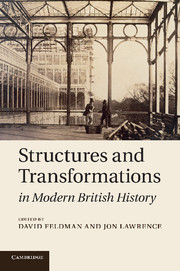Book contents
- Frontmatter
- Contents
- List of figures
- Notes on contributors
- Introduction: structures and transformations in British historiography
- 1 Coping with rapid population growth: how England fared in the century preceding the Great Exhibition of 1851
- 2 The ‘urban renaissance’ and the mob: rethinking civic improvement over the long eighteenth century
- 3 Forms of ‘government growth’, 1780–1830
- 4 Family formations: Anglo India and the familial proto-state
- 5 The commons, enclosure and radical histories
- 6 Engels and the city: the philosophy and practice of urban hypocrisy
- 7 The decline of institutional reform in nineteenth-century Britain
- 8 British women and cultures of internationalism, c.1815–1914
- 9 Psychoanalysis, history and national culture
- 10 Labour and the politics of class, 1900–1940
- 11 The dialectics of liberation: the old left, the new left and the counter-culture
- 12 Why the English like turbans: multicultural politics in British history
- Index
10 - Labour and the politics of class, 1900–1940
Published online by Cambridge University Press: 04 February 2011
- Frontmatter
- Contents
- List of figures
- Notes on contributors
- Introduction: structures and transformations in British historiography
- 1 Coping with rapid population growth: how England fared in the century preceding the Great Exhibition of 1851
- 2 The ‘urban renaissance’ and the mob: rethinking civic improvement over the long eighteenth century
- 3 Forms of ‘government growth’, 1780–1830
- 4 Family formations: Anglo India and the familial proto-state
- 5 The commons, enclosure and radical histories
- 6 Engels and the city: the philosophy and practice of urban hypocrisy
- 7 The decline of institutional reform in nineteenth-century Britain
- 8 British women and cultures of internationalism, c.1815–1914
- 9 Psychoanalysis, history and national culture
- 10 Labour and the politics of class, 1900–1940
- 11 The dialectics of liberation: the old left, the new left and the counter-culture
- 12 Why the English like turbans: multicultural politics in British history
- Index
Summary
Class feeling in Britain
Class feeling was written deep into the fabric of pre-1914 British society and culture. Stephen Reynolds, an Edwardian writer who ‘threw up’ middle-class society to live with a Devon fishing family, wrote that ‘there are two high walls between us and them; theirs and ours; and theirs is the higher and stronger. It's strange how undemocratic they are; how they look on “the gen'leman” as another species of animal.’ Similarly, in his memoir of growing up in an Edwardian ‘classic slum’, Robert Roberts recalled that ‘the real social divide existed between those who, in earning daily bread, dirtied hands and face, and those who did not’ – although he was equally clear that, internally, slum society represented a finely graded ‘social pyramid’ of class distinctions. As this suggests, there was no consensus about exactly where the lines of class were drawn, but few doubted that Britain was a society structured around deep, even impenetrable, class distinctions.
As Bernard Waites has argued, down to World War I it remained common to view this class-bound society through an essentially Tory lens: that is, as a ‘natural’ and immutable social hierarchy dictated by the rules of God and/or the market. But this perspective, long challenged by radicals and socialists, began to crumble under the strains of wartime mass mobilisation. The state was obliged to arbitrate between the competing interests of different social groups, which in turn came to see their own ‘sacrifices’ as disproportionate and unjust.
- Type
- Chapter
- Information
- Structures and Transformations in Modern British History , pp. 237 - 260Publisher: Cambridge University PressPrint publication year: 2011
- 5
- Cited by

